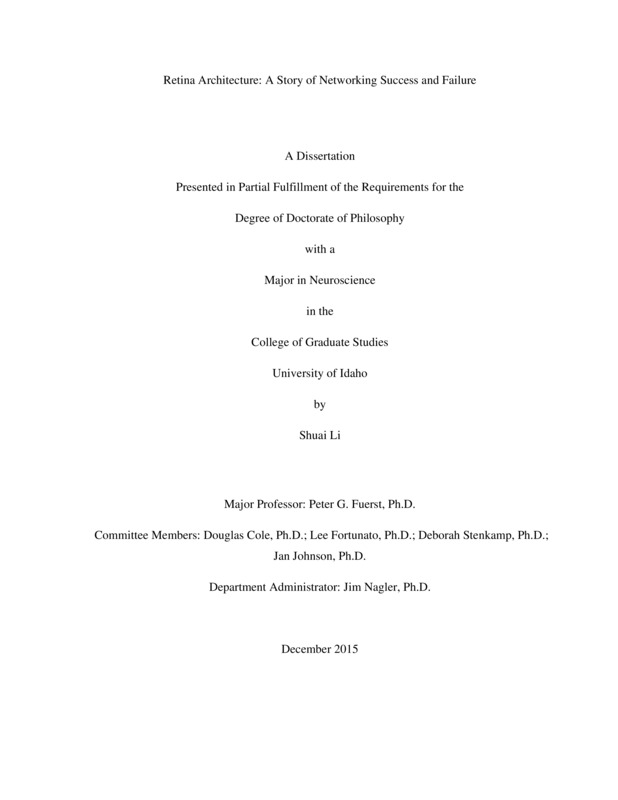Retina Architecture: A Story of Networking Success and Failure
Li, Shuai. (2015). Retina Architecture: A Story of Networking Success and Failure. Theses and Dissertations Collection, University of Idaho Library Digital Collections. https://www.lib.uidaho.edu/digital/etd/items/li_idaho_0089e_10432.html
- Title:
- Retina Architecture: A Story of Networking Success and Failure
- Author:
- Li, Shuai
- Date:
- 2015
- Embargo Remove Date:
- 2016-12-08
- Keywords:
- Cell Death Neural Refinement Photoreceptor Retina Architecture
- Program:
- Biology
- Subject Category:
- Biology; Neurosciences
- Abstract:
-
Neural circuitry is a fascinating system that animals possess, giving rise to our unique capacity to react to changes in our environment. It is my passion to describe and explain this wonderful capacity to anyone who wishes to learn some aspect of the nervous system.
There are three stages during the development of the nervous system. First, a precise regulation of the birth and death of neuron progenitor cells initiates neural tissue development. Second, a specific differentiation and migration pattern of those surviving progenitor cells in our tissue forms the basis of neuronal architecture that will support normal physiological function. Finally, in a process unique to neurons, they establish, eliminate and maintain appropriate neurite contacts over time in order to comprehend information-flow in complex neural networks.
Genetics is the essence of developmental processes. Some genes reveal multiple regulatory roles and make them significant targets because of their potential clinical value. Down syndrome cell adhesion molecule (Dscam), one of the 33 genes associated with the Down syndrome critical region, contributes to neural cell death, cell spacing and neurite lamination. These roles make Dscam an ideal candidate for understanding the complex process of neural developmental.
In my studies, we developed and utilized the first ever gain-of-function Dscam allele in the mouse model and assayed its role in all aspects to complement existing loss-of-function studies. We also developed software to efficiently quantify neurite patterning. Our results indicated that Dscam is sufficient to drive cell death and is necessary for precise lamination. We further demonstrated that Dscam and Bax are two faces of a double-safe mechanism in the neural circuitry to redundantly regulate cell populations and restrict their neurite targeting specificity. This type of functional redundancy protects us from severe neural developmental defects caused by genetic mutations, and also provides alternative insight into the treatment of genetic conditions.
- Description:
- doctoral, Ph.D., Biology -- University of Idaho - College of Graduate Studies, 2015
- Major Professor:
- Fuerst, Peter G
- Committee:
- Cole, Douglas; Fortunato, Lee; Stenkamp, Deborah; Johnson, Jan
- Defense Date:
- 2015
- Identifier:
- Li_idaho_0089E_10432
- Type:
- Text
- Format Original:
- Format:
- application/pdf
- Rights:
- In Copyright - Educational Use Permitted. For more information, please contact University of Idaho Library Special Collections and Archives Department at libspec@uidaho.edu.
- Standardized Rights:
- http://rightsstatements.org/vocab/InC-EDU/1.0/

